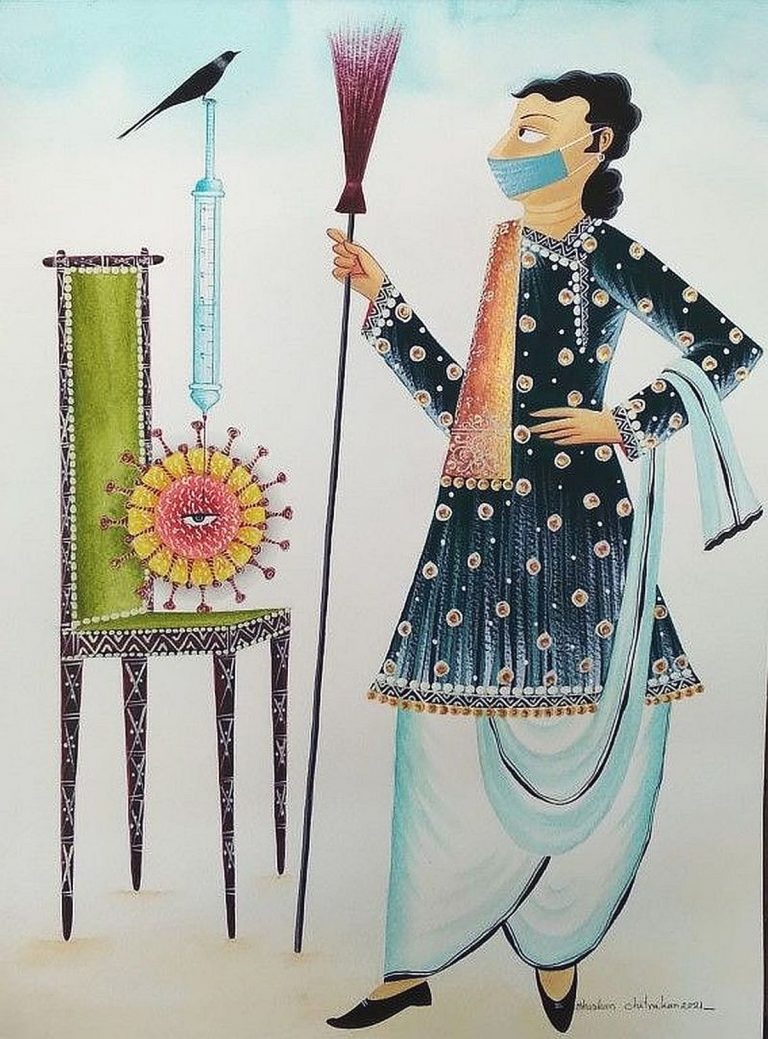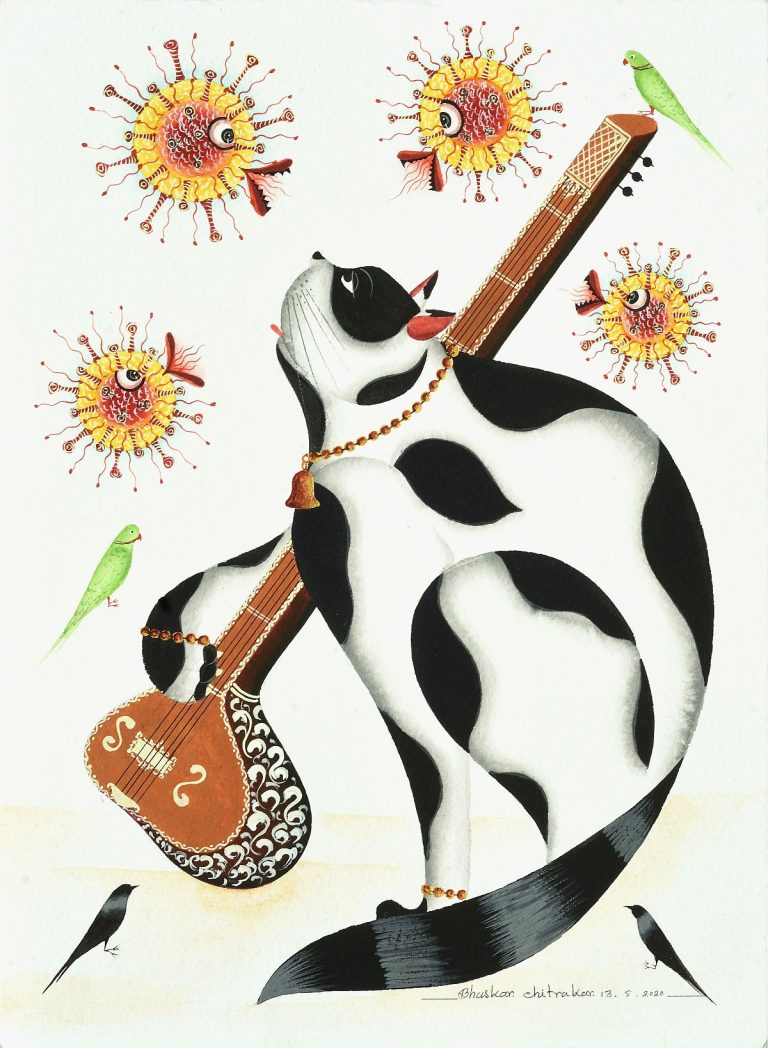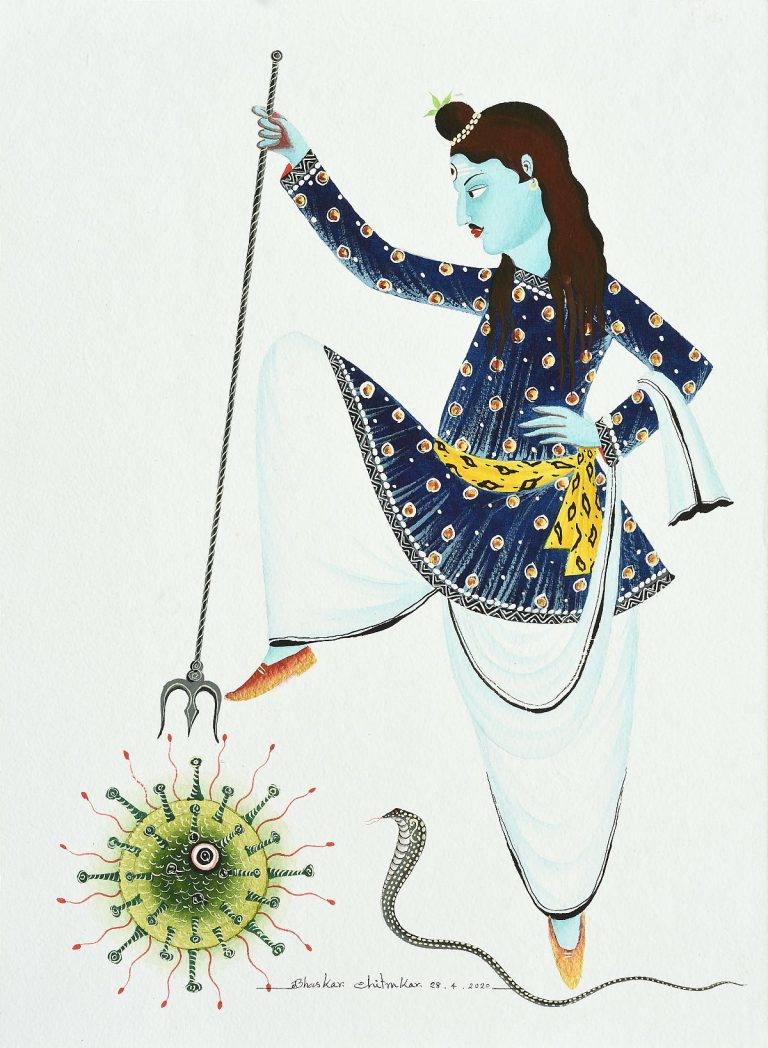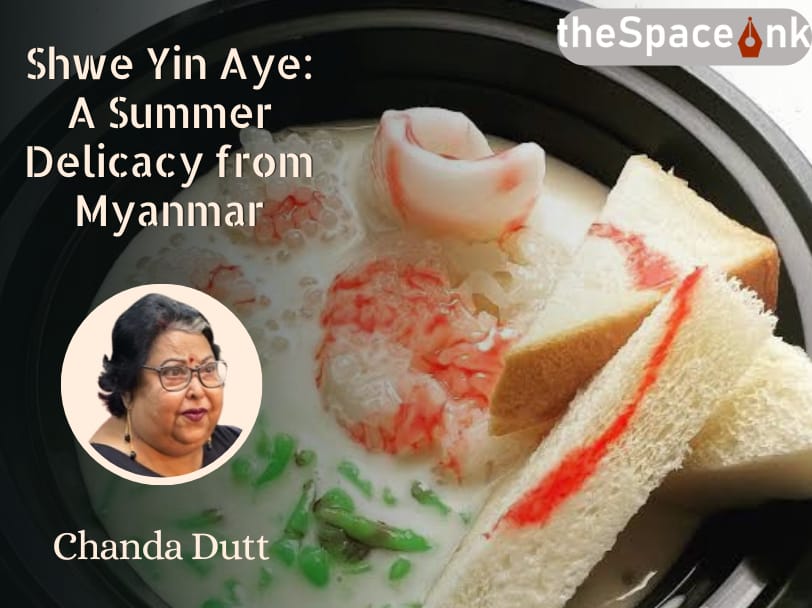Feeling besieged, tired and increasingly dejected amidst this third wave of the Corona pandemic that has engulfed Kolkata, I could not but cheer up on seeing the Corona pandemic series of Bhaskar Chitrakar. Bhaskar, now a well-known Kalighat pat artist, has an inimitable, whimsical style. His comments on the Corona virus are truly delightful and a mood booster.
How can anyone not be cheered on encountering an immaculately dressed masked Bengali gentleman attempting to vanquish the virus with a spear, and see that the Corona character has been quite taken aback by this unexpected attack? Who can resist being charmed by a large black and white cat playing the vina to keep the virus at bay? Even the parrots and crows are enthralled by the music despite their being surrounded by the Coronavirus. I certainly took heart when I saw a very determined Shiva destroy the virus with his trident and place his foot atop it to signal its destruction. The most elegantly dressed babu with his spotless and beautifully draped dhoti, elaborately designed kurta and shawl, pointed black polished mojris, holding up his purple broom preparing to dust off the corona virus that occupied his favorite green upholstered parlour chair is both beguiling and amusing.

It is reassuring to see Bhaskar so masterfully revive this patachitra art tradition making it relevant to contemporary society especially since it had been on a steep decline. He hails from a family of clay statue makers but his grand-father Kochi Ram Chitrakar, and his mentor renowned Kalighat artist Shirish Chandra Chitrakar encouraged him to paint. Bhaskar maintains the old techniques such as the use of powder pigments which he grinds using gum-arabic and chemicals so that the colours are lasting. Today he is the only Patua artist who lives and works in Kalighat.
The patachitra tradition developed in the by lanes of the Kalighat temple in the early 1820s. The Potuas (story tellers) migrated to the temple neighborhood from the surrounding rural districts, including Midnapur. They traditionally painted a series of illustrations, much like a series of screenshots, which would unfold as they sang their mythological stories and folk tales to rural audiences. The illustrations would help their listeners to understand their tales better. They applied their scroll painting techniques to create gods and goddesses for sale as religious souvenirs to visitors to the shrine. Over time, as they were gifted story tellers, their paintings moved from just devotional themes to wry social commentary on the Westernised city and its inhabitants. The paintings included unflinching representations of the eccentricities and lifestyle of the babus, their households and their mannerisms, as well as stories of romance. The British were not spared as subjects! Not surprisingly, their creations were popular both among devotees and visitors to the city and are the earliest examples of popular urban art of the city.

The patachitras were painted by a team of artists. The head Patua would begin the work and be responsible for the detailing. The pats were typically seven by eleven inches in size with the paper being backed by cloth. Bold black brush stroke, and bright colors characterized the style. The background was unadorned allowing the central motif to stand out better. Though the paintings were sold at throw-away prices, the style had considerable impact on modern Bengali art, including the style of Jamini Ray. When printed art flooded the market this art tradition waned – several patuas moved to fashioning deities from clay to earn a living and others moved back to Midnapore.
Developing an art series in response to the Corona crisis provides comic relief from the tragic situation in which we find ourselves. Though Bhaskar’s work includes devotional paintings, the predominant subject of his early works, his social commentary works have garnered greater popularity and promoted by Aban Desai of Tejas Art gallery.
Bhaskar, steeped in the Patachitra art tradition, is also a superb social commentator. His paintings of contemporary life are quirky and play on the traditional subjects. He adds some of the detailing of miniatures embellishing the Kalighat pat style. I see the plump cat in the coronavirus series as a play on the Bengali housewife who plays musical instruments in many of the earlier patachitras! The gentleman dusting off the clearly Westernized parlour chair, the pride of his living room, also plays on popular themes of the past where the Potuas mock the Babu Bibi culture. Developing an art series in response to the Corona crisis provides comic relief from the tragic situation in which we find ourselves. Though Bhaskar’s work includes devotional paintings, the predominant subject of his early works, his social commentary works have garnered greater popularity and promoted by Aban Desai of Tejas Art gallery.

Aban had opened Tejas Art Gallery, as an affordable art gallery in 2007, as a place where young artist could both exhibit and sell their works. Bhaskar, a young artist at that time approached her. Recognizing his talent and style Aban bought a few of his mythological works and encouraged him to work on more contemporary themes. Responding to her suggestions among his creations were a Babu Bibi series where the traditional babu and bibi are represented in contemporary modes – in a yellow taxi, rickshaw or a tram – proved popular among her clients in Delhi and Mumbai. More recently Aban introduced him to the iconic Frida Kahlo, an artist who paid tribute to traditional indigenous arts of Mexico. Frida, her painting and her story deeply resonated for Bhaskar, and she quickly became his muse. He has painted a wonderful series of portraits that were included in an exhibition on Frida that Aban curated where she invited local artists to represent Frida. The show was extremely popular. Tejas Gallery is on line at www.tejasgallery.com to see more of Bhaskar’s work.
Bhaskar’s art has gained considerable attention and he has one of his paintings now in the Smithsonian. Aban is delighted that he has been selected as one of 140 artists from across the world to participate in a folk-art show at Santa Fe, New Mexico.
Jael Silliman, born in Kolkata, was educated at Wellesley College, Mass., Harvard University, University of Texas, Austin. She received her doctoral degree in international education at Columbia University. She has written extensively on gender and economic development, and women’s movements in the developing world. 'The Teak Almirah', 'Where Gods Reside: Sacred Places of Kolkata', 'Jewish Portraits, Indian Frames: Women's Narratives from a Diaspora of Hope' are some of her published works.









2 Responses
Super article, Jael. Really like Bwork
Super article Jael. Really like his work